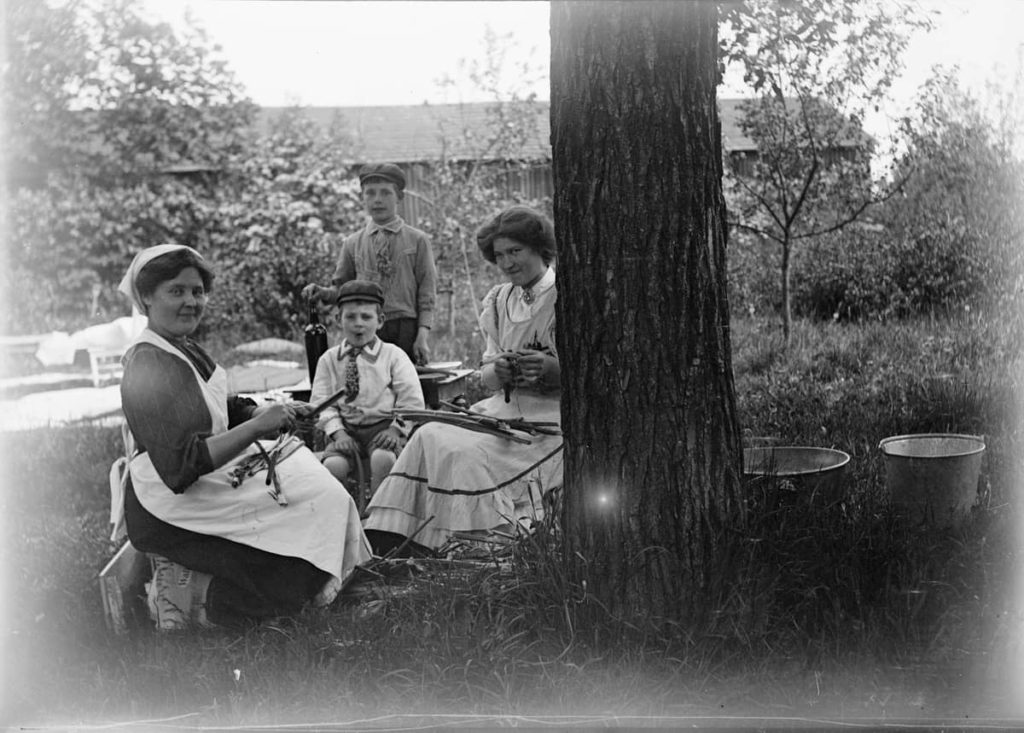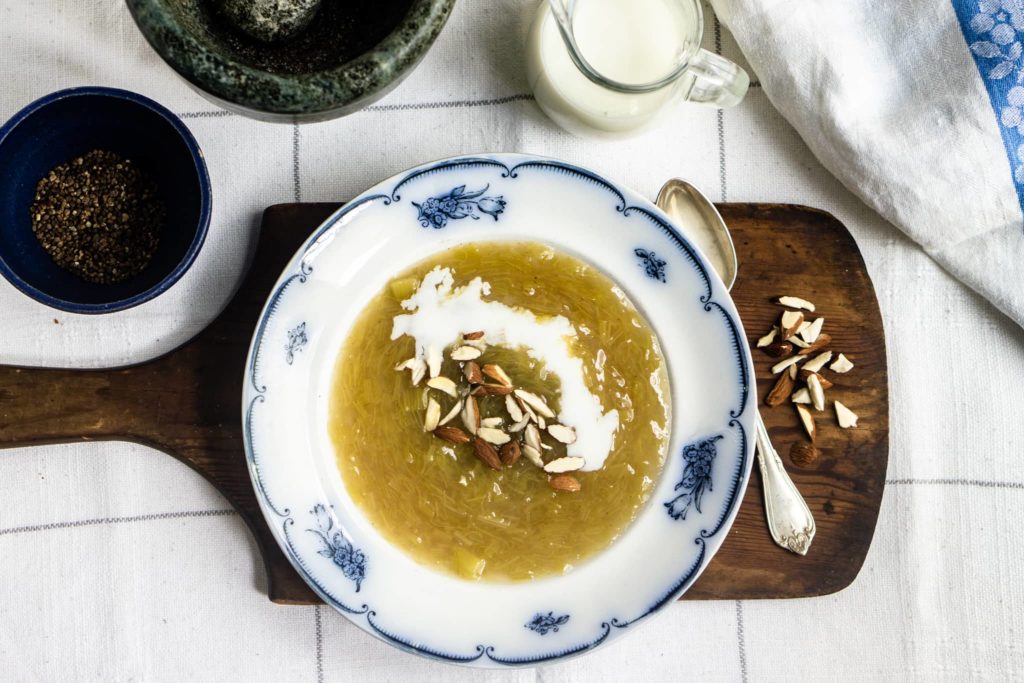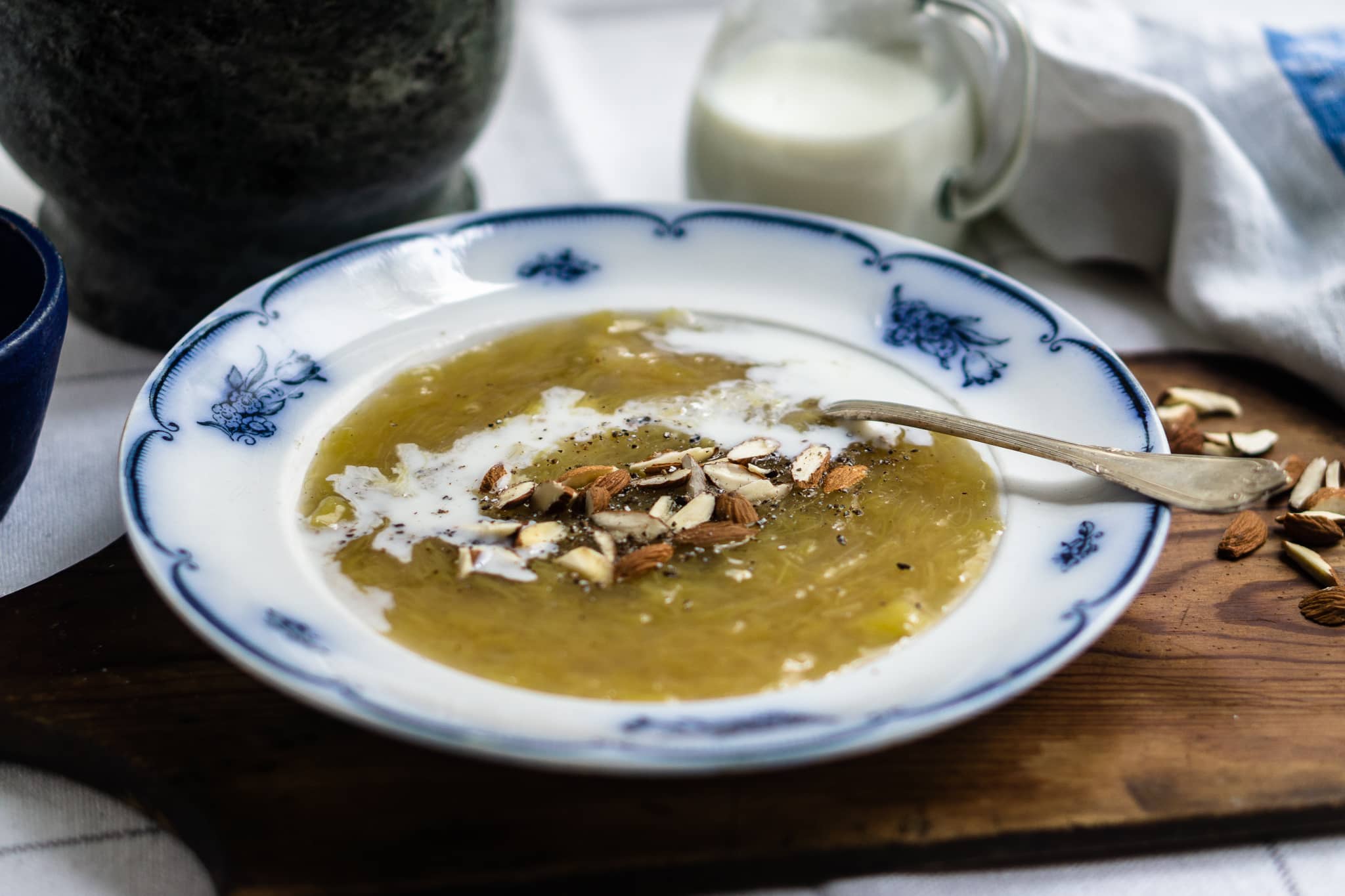What’s the best thing that Pippi Longstocking knows? You guessed it — rhubarb soup!

Unfortunately, I haven’t always been met with the same enthusiasm when making the dish.
“It looks like… are these octopus hearts?” The spoon fishes around in the bowl with rhubarb soup and holds up an unusually large, translucent blob as proof.
I’ll have to admit that it did look a little bit like a jellyfish. But potato starch lumps combined with long threads from unpeeled rhubarb stalks had given off associations to eight-armed sea creatures instead.
Well, that’s what happens when you boil rhubarb soup, heat the pot for too long and forget to stir it.
And I’m not the only one who’ve heard strange names for this otherwise pretty popular dish. Food writer Hiram writes in Svenska Dagbladet in 1980 that her father called the dish “stewed sheriff’s noses”. How very appetizing…
Now, how about we skip the sad associations and instead imagine Pippi’s favorite as a perfectly tart rhubarb soup. Don’t you feel a bit tempted?
Here, you can see how it’s made in stop motion animation:
Rhubarb in Sweden — a short history
Rhubarb isn’t particularly common in older cookbooks. It has been known in Sweden since the 1600s, but was originally grown for the medicinal purposes of the roots. According to an article in Svenska Dagbladet in May 1915, the French botanist Baillon imports to Sweden in 1867 a new type of rhubarb called Rheum Officinalis Baillon. Afterward this event, it became more common in Sweden to eat the stalks.
In my cookbook collection, the first mention is by Charles Emil Hagdahl, who published the first edition of his cookbook in 1879. Hagdahl mentions that the rhubarb comes from “Chinese Tartary” and has been unknown to outsiders for a long time due to the place’s inaccessibility. According to Hagdahl, the name came from rha, meaning drug or medicine, and barbarum, “from the land of the barbarians”.
Hagdahl suggests that the stalks should be stored in water-filled, lying bottles. He also claims that the stalks are better the thicker they are. We disagree on this point, Hagdahl and I — I find that the larger rhubarb stalks can turn a bit wooden and prefer to harvest the stalks continuously instead of allowing them to reach their maximum size.
A few years after Hagdahl, in 1884, Mathilda Langlet publishes Husmodern i staden och på landet. Here, rhubarb appears as a recommendation for what should be part of the house’s medicine cabinet. Jan-Öjvind Swahn writes in Mathistorisk uppslagsbok that the food rhubarb’s relative, Chinese rhubarb, was used for stomach medicine until late in the 19th century.

Rhubarb soup — how long have we eaten it in Sweden?
It should be clear by now that the Swedish people is fond of sweet soups. We’ve previously looked at blueberry soup, rosehip soup, and raspberry soup. As rhubarb doesn’t become popular in Sweden until the end of the 19th century, it’s now wonder that it is at that time we can start to find rhubarb recipes in the cookbooks.
The oldest recipe called “kräm” (the Swedish word for thick, sweet soup) is “Bavarian kräm with tender rhubarb stalks“, which turns out to be a dessert with gelatine that sets in a cold and is decorated with whipped cream and meringues. Not that similar to the humble dessert we enjoy today…
Instead, it is Hagdahl’s recipe of stewed rhubarb stalk that is closer to today’s recipes. In this recipe, he cooks the rhubarb pieces separately and then heats them in a sugar syrup, finishing by thickening it all. I feel that it is a bit unnecessary to boil the pieces separately. In the end, they will get soft and mushy anyway.
Mathilda Langlet also features a recipe for stewed rhubarb, which can be made in different ways:
- Peel the rhubarb stalks and cut them into pieces. Boil them with brown sugar, red wine, cherry sauce, and water. Thicken it all with potato starch “so that it becomes like a porridge or thick soup”.
- Cut unpeeled rhubarb stalks into pieces and boil them in water until soft. Sweeten it and thicken with potato starch that you’ve wet with a little wine.
- Cut the stalks across, “not into pieces but thin slices” to avoided thready soup. Boil the rhubarb in water, lemon and sugar and thicken with potato starch.
Langlet suggests that the last version is the most common. No matter if you choose to add wine or not, there’s one instruction that Langlet won’t negotiate on: “all rhubarb soup is to be served cold with sweetened whipped cream.”

Rhubarb soup in the 20th century
In the beginning of the 20th century, rhubarb eating apparently declined after warnings of the dangers of oxalic acid. “A lot of people avoid this green”, Jochum writes in Svenska Dagbladet in May in 1936. But if you should eat it, Jochum recommends other dishes than soup — “may heaven preserve us from rhubarb soup with potato starch”.
Despite the oxalic acid warnings and Jochum’s distaste, rhubarb soup seems to have been a pretty popular dish during the 20th century. A search in Svenska Dagbladet’s digital archives shows that you’ll find it constantly in various weekly meal plans. At least in 1952, it starts appearing over the lists for school lunches in Stockholm, where it was served together with sandwiches.
In 1944, Svenska Dagbladet’s recipe column states that “it is pretty difficult with sugar at the moment” due to rationings, but you can instead sweeten the soup with honey if you have it. In 1949, another article suggests that you can thicken the rhubarb soup with semolina flour and boil it with ginger for extra flavor.

How to make the tastiest Swedish rhubarb soup
No matter what Mathilda Langlet said, you can serve this soup cold, warm, or even lukewarm — it is up to you. Here’s a recipe based on one from Stora kokboken from 1946. See it as a starting point and adjust the sweetness and extra seasoning depending on your preferences.
Ingredients
6 small-to-medium rhubarb stalks, about 1/2 kilo (2 pounds)
12 dl (5 cups) water
1 1/2-2 dl (1/2 to 4/5 cup) sugar, or more, to taste
peel of 1/2 lemon (optional)
1/2-1 tsp ground cardamom (to taste, optional)
1 1/2 tbsp potato starch or cornstarch
To sprinkle over:
lemon juice of 1/2 lemon
1-2 tbsp sugar
Serving:
chopped nuts or almond macaroons
milk, cream or ice cream.
Method
- Wash the stalks and peel them if you like. Cut them into pieces, about 2 1/2 cm (1 inch) long.
- Bring the water to a boil and add the rhubarb together with the sugar — start with the lower suggested sugar amount.
- Let it simmer until the rhubarb starts to soften. Add the lemon peel and cardamom, if using. Taste test to see if you want to add more sugar.
- Dilute the potato starch or cornstarch with a little bit of cold water, then add it to the soup whilst stirring. Bring the soup to a boil, then remove it from the heat. If you used cornstarch, you can let it boil for 2-3 minutes.
- If you’re serving the soup from a serving bowl, sprinkle a little bit of extra sugar on top so it doesn’t form a thick skin. Sprinkle the lemon juice over the soup. Enjoy it straight away or store the cooled soup in the fridge.
Suggestions
An article in Svenska Dagbladet in 1987 suggests that you should be careful with enjoying milk products such as milk with the rhubarb soup. Apparently, the calcium from the milk in combination with the soup produces calcium oxalate, resulting in kidney stones. I’ve never had any such issues, nor heard about anyone getting them from rhubarb soup with milk. However, if you are sensitive to these things, you may want to skip the milk and just enjoy it with plant-based milk and some cardamom rusks.
You can vary the flavor of this soup however you like. I enjoy spicing it up with cardamom. Maybe vanilla or ginger floats your boat? Serve it with chopped nuts, crushed-up cookies, or why not granola. Milk, cream, or vanilla ice cream are popular as well.
I got a bit “burned” by the octopus heart incident and tend to peel the rhubarb stalks. There’s no need to do that if you clean them well and cut them in small pieces — in fact, then you’ll get a more beautiful, rosy color.
Stora kokboken suggests that you can color the soup red with a cordial. That’s also a simple way to sweeten the soup, so you can lower the amount of sugar if using a lot of cordial. A strawberry cordial makes for a delicious pairing.



0 Comments